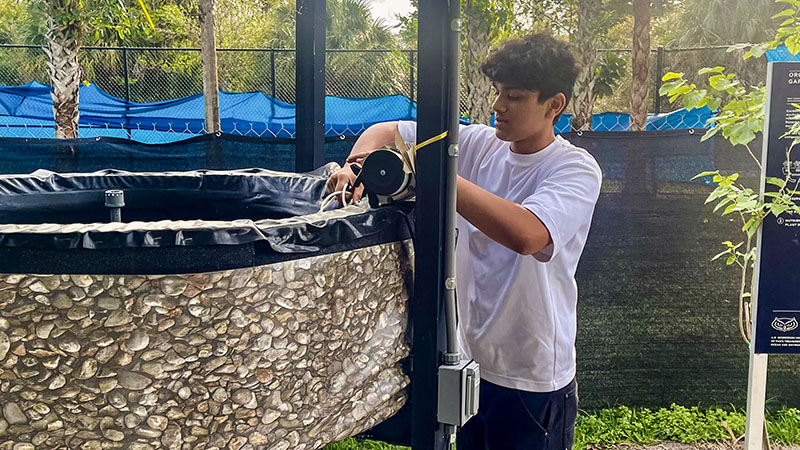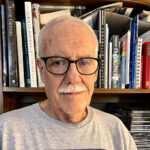
Yashwin Adusumilli of Parkland. {courtesy}
By Martin Lenkowsky
While fishing with his father, Yash knew something was wrong with the seawater because of its eerie appearance and smell.
“It was a deep reddish-brown color, and the smell was horrible,” said Parkland Bay resident Yashwin “Yash” Adusumilli, 15.
A junior at FAU High School, Yash and his father, Krishna, were fishing last summer on a small beach in the Florida Keys when his observation led to his award-winning research.
The source of the foul odor was evident to Yash. “It was a large fish kill. All kinds of species, all different shapes and sizes,” he said, adding that government officials there telling people not to go in the water.
His curiosity was piqued by what he saw. “I decided to do some research,” he explained, and discovered the culprit was an algae bloom and nutrient pollution, which is caused by pesticides and other chemicals running off into the ocean, which can lead to destructive algae bloom.
He added that research has indicated that in just 10 to 20 more years, excess pollution seeping into our waterways will become a serious problem in South Florida.
The inquisitive teen was already in the dual enrollment program at FAU High School, which enables him to take high school and college courses simultaneously.
Yash applied to FAU High School as an eighth-grader at Westglades Middle School in Parkland. He talked to some alumni about all the research they do, and that convinced him to apply.
He attends classes at the Harriet Wilkes Honors College on the FAU campus in Jupiter but still has access to the lab on the Boca Raton campus. Yash says his father and mother, Prathima, drive him to and from the FAU Boca Raton campus daily, and from there, he takes an inter-campus shuttle to the honors college and back.
Yash’s research led him to discover the potential of gracilaria, a species of seaweed that shrimp fishermen in China use to absorb excess nutrients and prevent destructive algae blooms. “It’s used in Chinese shrimp farms. I asked, why can’t we use that here?”
Gracilaria is found worldwide but only in limited quantities in our local waters. He obtained some of this seaweed from FAU’s Harbor Branch Oceanographic Institute in Fort Pierce, where researchers were already doing research.
He began his experiment by setting up two 300-gallon saltwater tanks, replicating the exact water conditions found in Everglades marshes. In both tanks, he added water-soluble fertilizer. One tank served as a control. The gracillaria was only added to the second tank.
Yash monitored the water chemistry in both tanks. Sure enough, his hypothesis was correct. The control tank (without the seaweed) had an algae bloom, and all its oxygen was depleted. With the added seaweed, the test tank maintained normal chemistry levels and didn’t experience an algae bloom.
His extensive research did not go unnoticed. He was recently given the honor of presenting his groundbreaking environmental project findings at the prestigious BIP Purdue conference, where he was awarded the grand prize of $10,000.
Regina Thompson is familiar with Yash’s innovation and manages FAU’s Florida Atlantic Wave Program. It’s a highly competitive program that invites students to present innovative ideas. Yash applied and was accepted; only about 15 projects are accepted university-wide. Once accepted, students meet monthly with a mentor and receive $500 seed money.
Yash also had other project ideas, but they decided to go with the seaweed concept because he’d already done extensive background research. Thompson says he’s young and motivated. “It’s great when the younger generation sees a problem and tries to solve it,” she said.
Katherine Hendrickson is the research coordinator at FAU High School, guiding Yash since he submitted his idea to naturally capture all the excess nutrients during the summer.
She was impressed by how Yash came up with the idea for his project. “It’s really about the power of observation,” Hendrickson said, adding students are encouraged to observe problems and look toward nature to help solve them.
According to her, the initial pilot tests have yielded positive outcomes. However, these positive results must be replicated in future trials to confirm their accuracy. Moving forward, Hendrickson wants to collaborate with environmental permitting agencies to test the system under natural conditions.
Send your news to Parkland’s #1 Award-Winning News Source, Parkland Talk. Don’t miss reading Tamarac Talk, Coral Springs Talk, Coconut Creek Talk, and Margate Talk.
Author Profile

Related
 NewsMarch 23, 2025Parkland’s Matheus Maldaner Named to UF Hall of Fame, Excels in AI Research and Leadership
NewsMarch 23, 2025Parkland’s Matheus Maldaner Named to UF Hall of Fame, Excels in AI Research and Leadership NewsFebruary 26, 2025Parkland Entrepreneur Brings Mah Jongg Lovers Together on Cruises and Global Adventures
NewsFebruary 26, 2025Parkland Entrepreneur Brings Mah Jongg Lovers Together on Cruises and Global Adventures NewsFebruary 12, 2025Parkland Woman Wins Big At Seminole Casino Coconut Creek
NewsFebruary 12, 2025Parkland Woman Wins Big At Seminole Casino Coconut Creek NewsJanuary 23, 2025Parkland Kids Donate Chuck E. Cheese Prizes to Children’s Hospital
NewsJanuary 23, 2025Parkland Kids Donate Chuck E. Cheese Prizes to Children’s Hospital












